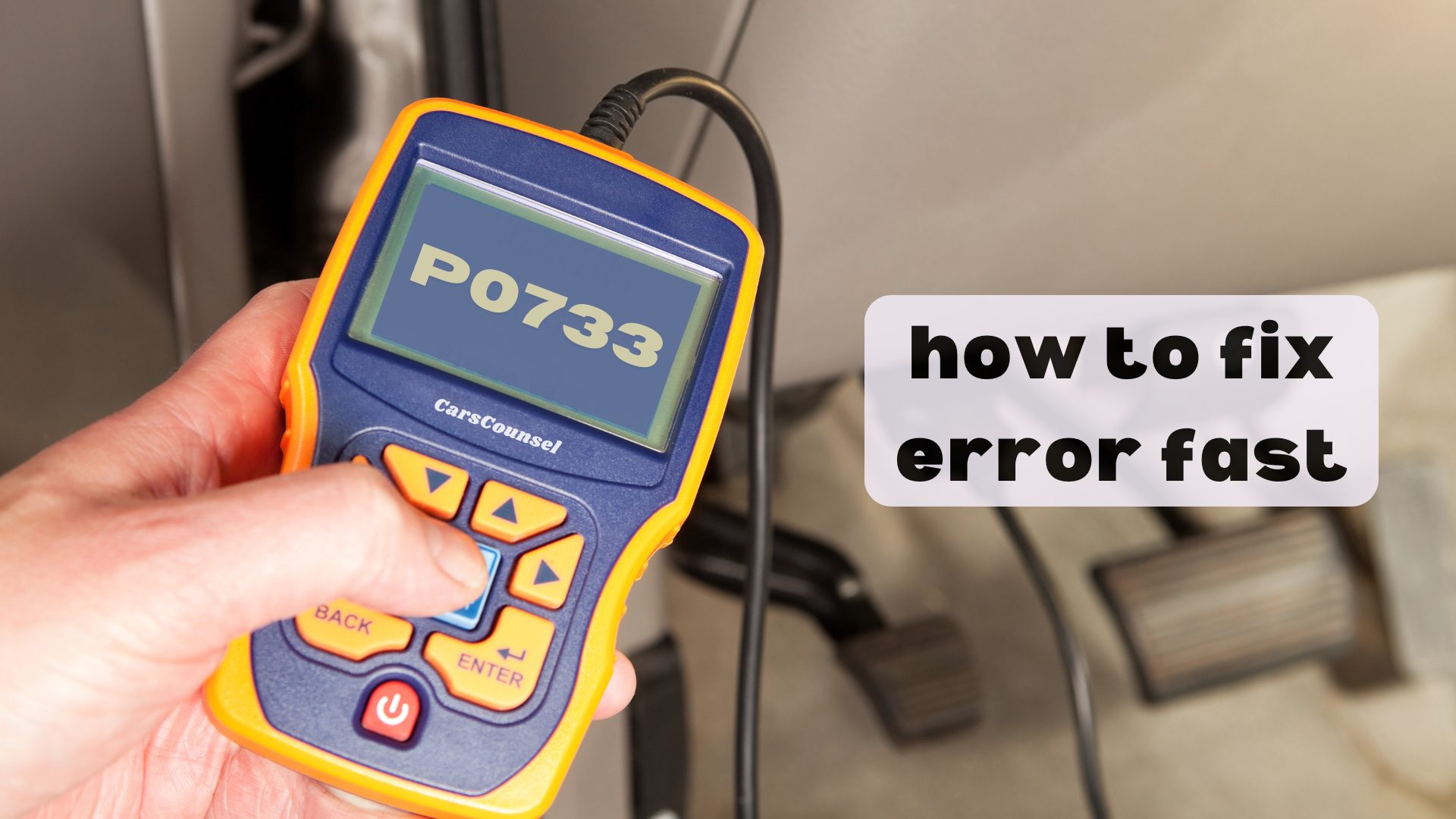The P0733 code can really mess up your car if you don’t fix it quickly. You might see signs like rough shifting or a check engine light, which point to transmission problems.
To fix it, start by checking your transmission fluid level and quality—low or dirty fluid often causes issues.
Also, make sure to inspect the clutches and test the shift solenoid.
Don’t forget to check the wiring and look into possible OBD2 fixes for the Transmission Control Module.
Knowing these steps can save you time and prevent bigger problems down the road.
What’s your first step?

Quick Navigation
Key Takeaways
- Check the transmission fluid and add more if it’s low.
- Look at the shift solenoids and replace any that aren’t working.
- Fix or replace any damaged wires and connectors.
- Clean or replace any sensors that aren’t working right.
Understanding the P0733 Code
The P0733 code means that your car’s automatic transmission is slipping, specifically in third gear. This often happens because the transmission hasn’t been properly maintained and can really mess up how your gears work.
To keep your transmission in good shape, make sure you get regular check-ups and change the transmission fluid as recommended by the manufacturer.
Also, look out for worn-out clutches and ensure the transmission control module (TCM) is working properly. Fix any wiring problems right away to avoid more issues.
Symptoms of P0733 Code
When your car’s transmission slips because of the P0733 code, you’ll notice poor acceleration, especially when driving on the highway. The transmission doesn’t work as well, causing the engine to rev up without making the car go faster.
Shifting gears becomes slow or rough, making the drive less smooth. You might also experience the gears slipping during acceleration, which is both annoying and unsafe.
Additionally, you’ll see a drop in fuel efficiency as the engine works harder to make up for the transmission problems. Transmission overheating is another sign, which can lead to more issues.
It’s important to fix these problems quickly to avoid serious damage and expensive repairs. Getting the problem diagnosed and repaired on time can bring back the transmission’s top performance and ensure safer, more efficient driving.
Common Causes of P0733
Worn clutches often cause the P0733 code, leading to transmission slippage and incorrect gear ratios. Low transmission fluid, whether not enough or dirty, can also trigger this error. A bad shift solenoid can mess up the fluid flow, affecting how the gears work. Problems with the wiring connected to the transmission system might also cause the P0733 code. Lastly, a faulty Transmission Control Module (TCM) can be the issue.
| Cause | Impact on Gear Performance |
|---|---|
| Worn Clutches | Slippage, incorrect ratios |
| Low Transmission Fluid | Slipping, ratio issues |
| Faulty Shift Solenoid | Disrupts fluid flow |
| Wiring Issues | Transmission malfunction |
Regular maintenance, like checking the fluid and doing timely repairs, is key to avoiding these problems.
Affected Car Models
Many cars, like the Chrysler PT Cruiser (2001-2010) and older Audi A4 models, often run into the P0733 code because of transmission problems.
For Chrysler, the issues usually come from worn-out clutches and low transmission fluid, leading to gear ratio troubles. With Audi, the problems typically involve bad shift solenoids and fluid leaks, which can cause the transmission to slip.
Other cars that can have this problem include the BMW 7 Series (E65) and various other cars with automatic transmissions.
To avoid these issues, make sure to keep up with regular maintenance like checking the fluid and making timely repairs. Catching these problems early can help you avoid serious transmission damage and expensive repairs.
Keep an eye on any changes in how your car drives, as they might be early signs of transmission trouble.
Diagnosing the P0733 Code
Diagnosing the P0733 code starts with checking the transmission fluid to make sure it’s at the right level and in good condition.
Use a diagnostic scanner to confirm the P0733 code and see if there are any other codes.
Look at the clutches for wear, as worn clutches can often cause incorrect gear ratios.
Test the shift solenoid to make sure it’s working properly and regulating fluid flow correctly.
Check the wiring connected to the transmission for any issues that might affect performance.
Take the car for a road test to see if you can replicate the symptoms and observe how the vehicle shifts.
Accurate transmission diagnostics are essential to find the real cause of the incorrect gear ratio, ensuring you fix the actual problem and avoid unnecessary repairs.
Checking Transmission Fluid
How to Check Transmission Fluid
Make sure your car is parked on a flat surface and the engine is warmed up. This helps you get an accurate reading of the transmission fluid. Here’s what to do:
- Find the Dipstick: Look for the transmission dipstick. It’s usually marked and located near the engine.
- Check the Fluid Level: Pull out the dipstick, wipe it clean, put it back in, then pull it out again to see the fluid level.
- Look at the Fluid: Good transmission fluid should be clear and reddish. If it’s dark or smells burnt, it needs to be replaced.
Always use the type of fluid recommended in your owner’s manual.
Checking and maintaining your transmission fluid regularly can help avoid problems and make your transmission last longer.
Inspecting Clutches
To inspect the clutches properly, you need to check for wear and tear since this often causes transmission slipping and the P0733 code.
Start by getting to the transmission’s clutch assembly. Look for signs of wear, like burnt spots, shiny surfaces, or uneven material. If you see any of these issues, you might need to replace the clutch.
Use a micrometer to measure the clutch thickness and compare it to what the manufacturer recommends. Also, check the clutch plates and springs for any damage or bending.
If the clutches are worn out, replace them to fix the gear ratios and stop more slipping. A good clutch inspection can help you avoid bigger transmission problems later on.
Testing Shift Solenoid
When testing the shift solenoid, start by disconnecting the transmission’s electrical connector and use a multimeter to measure the solenoid’s resistance. You can find the right resistance value in your vehicle’s service manual. If the resistance is outside the acceptable range, the solenoid is faulty and needs to be replaced.
Here’s a simple guide for shift solenoid testing and repair:
- Disconnect the Connector: Make sure the vehicle is turned off and safely lifted, then disconnect the transmission’s electrical connector.
- Measure Resistance: Use a multimeter to check the resistance of the shift solenoid.
- Compare Values: Compare the measured resistance with the manufacturer’s specifications. If the values don’t match, replace the solenoid.
Accurate solenoid testing can save you from more extensive transmission repairs.
Evaluating Wiring Issues
After testing the shift solenoid, take a look at the wiring connected to the transmission to check for any damage or wear.
Start by visually inspecting all the electrical connections for frayed wires, rust, or loose plugs. Use a multimeter to check for continuity to make sure there are no breaks in the circuit.
Pay extra attention to connectors and junctions, as these are common trouble spots. If you find any damaged wires or bad connections, fix or replace them right away.
Secure and intact wiring is crucial for accurate transmission signals. Always refer to your vehicle’s service manual for specific wiring diagrams and connection points to ensure a thorough inspection and troubleshooting.
Fixing and Prevention Tips
Replacing worn-out clutches is crucial for fixing transmission slippage and stopping the P0733 code from coming back.
To ensure smooth gear shifting and prevent future problems, follow these transmission maintenance tips:
- Check Fluid Regularly: Make sure the transmission fluid is at the right level and not dirty. Low or dirty fluid can cause slipping.
- Look at Shift Solenoids: Regularly check and replace any bad shift solenoids to keep gears shifting smoothly.
- Inspect Wiring and Connections: Regularly check and fix any damaged wires or loose connections to avoid transmission problems.
More OBD-II Codes
Frequently Asked Questions
Can Aftermarket Parts Affect the P0733 Code?
Yes, aftermarket parts can affect the P0733 code. Make sure the aftermarket parts are compatible to keep your transmission working right. Poorly fitting or low-quality parts can cause slippage, wrong gear ratios, and other transmission problems. Always check compatibility before installing them.
How Does Driving in Manual Mode Impact the P0733 Code?
Driving in manual mode can hide the signs of a bad automatic transmission. However, bad shifting habits in manual mode can make the P0733 code problems worse. Always use good driving techniques to avoid damage.
Are There Any DIY Transmission Fluid Flush Kits Recommended?
If you’re looking to do a transmission fluid flush yourself, you might want to check out brands like Mityvac or OEMTOOLS. It’s really important to use the fluid your car’s manufacturer recommends. Keeping up with regular transmission maintenance and using the right fluid will help your car run smoothly and last longer.
Is It Safe to Drive With a P0733 Code Temporarily?
Driving with a P0733 code for a short time is risky. Symptoms like gear slipping and poor acceleration can get worse, causing serious damage to the transmission. Fix the problem right away to avoid expensive repairs and ensure safe driving.
What Are the Costs Associated With Professional Transmission Diagnostics?
Finding out what’s wrong with your transmission can be pricey. Getting it checked by a professional using high-tech tools usually costs between $80 and $120. Fixing the transmission can be even more expensive, ranging from $1,000 to $4,000, depending on how bad the problem is.
Conclusion
To fix a P0733 code quickly, start with the basics: check your transmission fluid levels and condition.
Did you know that most transmission problems are due to fluid issues?
Look at and change worn clutches, test and replace bad shift solenoids, and check the wiring for damage.
If these steps don’t solve the problem, you may need to reprogram or replace the Transmission Control Module (TCM).
Regular maintenance is key to avoiding future problems.

